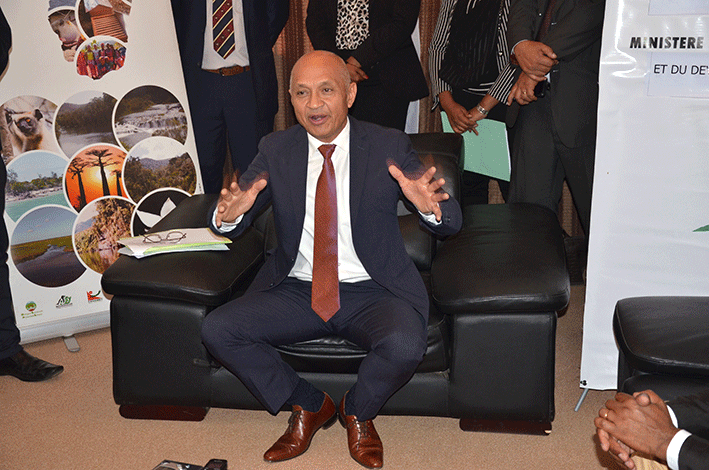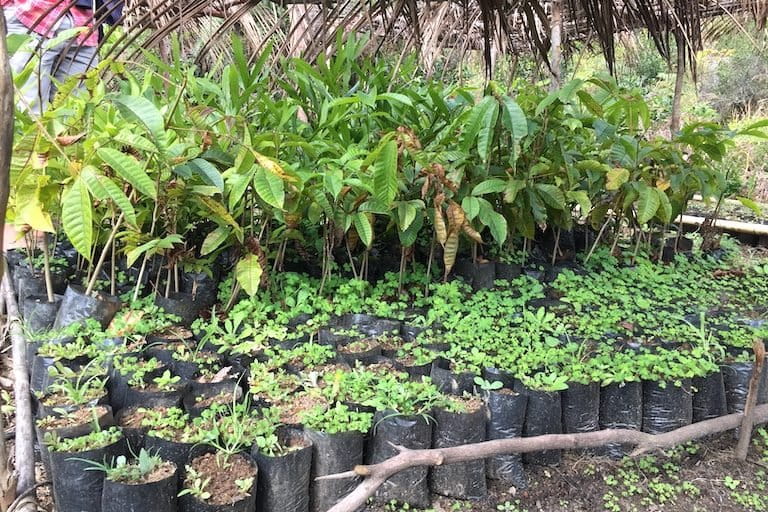- Alexandre Georget, a founder of Madagascar’s first green party in 2008, is the country’s new environment minister.
- In an interview with Mongabay, Georget discussed the government’s reforestation plans and outlined how he expected to approach its 2019 goal of reforesting 40,000 hectares.
- He also described the government’s new position on the sale of confiscated illegally harvested precious timber, in advance of the upcoming CITES meeting in August.
In 2008 Alexandre Georget, Madagascar’s current environment minister, helped found the country’s first green party, Vert Hasin’i Madagasikara. He did so with his then wife, Saraha Rabeharisoa, to bring attention to pressing environmental issues that plague the sprawling island nation, 90 percent of whose plant and animal species are found nowhere else on Earth.
Georget was appointed the environment minister by President Andry Rajoelina, who took office in January this year after a bitterly fought election. Since gaining independence in 1960, Madagascar has faced frequent political turmoil, and some hope that an era of political stability could be leveraged for better environmental protection. Addressing the U.N. Environment Assembly in March, the president declared that the island nation would reforest between 40,000 and 80,000 hectares (between 98,800 and 197,600 acres) of land every year. Under the Bonn Challenge, the country has already committed to reforest 4 million hectares (9.9 million acres) of land by 2030, a goal distant from the president’s most ambitious declared annual targets.
Madagascar has lost about half of its forests since the 1950s, and they continue to be razed at an alarming pace. High rates of poverty translate into heavy dependence on forests and massive illegal logging.
Georget spoke to Mongabay recently by phone, explaining the environmental priorities of the Madagascar government, how it plans to meet its ambitious reforestation target, its position on the illegal trade in precious wood, and what role NGOs can play.

Mongabay: What are the government’s priorities in terms of the environment?
Alexandre Georget: The environment touches everything. Some of the problems in Madagascar exist everywhere in the world, so it is a transnational problem. For us, protection of biodiversity, forests and flora and fauna are priorities. We plan to plant trees at a very vast scale.
How will you meet the 40,000 hectare per year reforestation target?
Our target for this year is very few [hectares] because we just [have] five months and we [are] expected to plant more than 40,000 hectares of forests. In five months we plan to meet about 85 percent of our target. All the people working with me from the provinces will come for a meeting on July 17, 18 and 19. We will give a direction to collect all the seeds in Madagascar. We have to declare seeds a strategic resource for the government, forbidden for taking until we finish our planting.

How do you plan to use the seeds?
We plan to start in October. We will use planes to distribute seeds on a very vast scale. The question is how to collect all these seeds, which will be discussed during this meeting on July 17 to 19 with the responsible officials from the provinces. Right now we are using traditional methods; you make a hole in the ground and you plant small trees from nurseries. But now we will try planting seeds using planes and drones.
Are these indigenous species?
Yes, we collect these seeds from our protected areas. We cannot plant other species because it is dangerous for our endemic trees.

Which areas are you planting them on? Are these degraded areas?
Everywhere; we are planting everywhere, everywhere in Madagascar. Secondly we have to reforest all our protected areas, where thieves come to pick up our trees. We have to reforest inside and outside our national parks.
The CITES meeting is coming up in August. What is the government’s position on the sale of the seized precious wood? (Editor’s note: The international sale of precious timber from Madagascar is illegal under CITES. The Madagascar government, under the previous administration, has been petitioning CITES for permission to sell off its stockpiles of illegally logged precious timber, valued at between $25 million and $300 million.)
It is forbidden. I issued a verbal note for zero tolerance on ebony, rosewood and palisander and all hardwood. It is not possible even to use locally, it is not allowed. No exportation, no national use.
So no national use and no export?
No.

How do you balance the twin priorities of economic development and conservation?
I plan to import wood from abroad so as not to penalize the factories. I don’t want to cut our use, I am looking for a good channel to do that.
What kind of role do you see for foreign actors and NGOs?
I have big trouble with NGOs because normally they receive money on behalf of the Madagascar government because they need our authorization [to conduct conservation work]. But once they receive the budget, for example $1 million, they spent half of this money to pay their head office, then a quarter of this money for reinforcing capacity, and the rest on traveling and staying and nothing for planting. But now before they get authorization to accept funds they have to reserve 40 percent for reforestation — otherwise no authorization.
I just want to give the message to people from abroad to help us in our fight.

Banner image: Rainforest at Tampolo on the Masoala Peninsula, Madagascar. Image by Rhett A. Butler.
Malavika Vyawahare is a staff writer for Mongabay. Find her on Twitter: MalavikaVy.
Editor’s note: This interview has been lightly edited for clarity and length.
FEEDBACK: Use this form to send a message to the editor of this post. If you want to post a public comment, you can do that at the bottom of the page.
